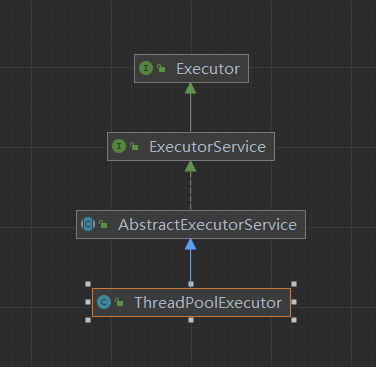Java執行緒池ThreadPoolExecutor極簡教學
ThreadPoolExecutor 簡介
ThreadPoolExecutor 是 java.util.concurrent 包下的一個類,在jdk1.5版本引入,幫助開發人員管理執行緒並方便地執行並行任務。
通俗來說,ThreadPoolExecutor 的作用是生產和管理執行緒池的,可以通過呼叫其 execute 方法和 submit 方法執行多執行緒任務。
ThreadPoolExecutor 使用
建立執行器
ExecutorService 物件和 ThreadPoolExecutor 的關係如下圖:

ExecutorServiceConfig:
package com.ramble.threadpool.config;import java.util.concurrent.*;
public class ExecutorServiceConfig {
/**
* 定義一個並行任務執行器服務
*/
private static ExecutorService executorService;
/**
* 在類載入的時候初始化並行任務執行器
*/
static {
init();
}
/**
* 防止類屬性被篡改
*/
private ExecutorServiceConfig() {
}
/**
* 初始化並行任務執行器。核心執行緒數量:設定為2,初始建立的執行緒池大小;最大執行緒數量:設定為3;空閒執行緒存活時間:設定為3秒,當非核心執行緒執行完任務之後,若沒有新的任務分派,存活多久後自動銷燬;任務佇列:設定為2,當執行緒池建立的執行緒數量達到最大執行緒數量後,新進來的任務會排隊等候;
* 拒絕策略:設定為直接拋異常
* <p>
* 以上設定需要根據:實際的業務場景、專案實際情況、實際硬體情況等各種因素綜合考量
*/
private static void init() {
executorService = new ThreadPoolExecutor(2, 3, 3, TimeUnit.SECONDS, new LinkedBlockingDeque<Runnable>(2), new ThreadPoolExecutor.AbortPolicy());
}
/**
* 獲取預設並行任務執行器
*
* @return
*/
public static ExecutorService getDefaultExecutor() {
return executorService;
}
/**
* 獲取固定大小並行任務執行器
*
* @return
*/
public static ExecutorService getFixedExecutor() {
return Executors.newFixedThreadPool(10);
}
/**
* 獲取其他並行任務執行器
* @return
*/
public static ExecutorService getOtherExecutor() {
//todo
return null;
}
}
-
這個類的核心目的是構造一個 ExecutorService , 供業務程式碼呼叫。當業務程式碼需要建立執行緒執行任務的時候,不用建立、管理和維護「執行者(執行緒)」,只需要告訴 ExecutorService 需要做什麼 「事情(任務)」。
-
ExecutorService 物件必須是單例的,因為此物件本身是管理執行緒池的,如果自己都不是執行緒安全的,那使用起來將有可能發生災難。
-
一個java程序允許建立多個ExecutorService 。根據業務實際情況,如果業務邏輯比較單一,大概率建立一種就滿足使用。若業務繁雜,可根據業務特性抽象出多種型別以滿足不同需求。譬如程式碼中就建立了兩個 getDefaultExecutor 和 getFixedExecutor
-
關於執行緒池設定,如核心執行緒數量、最大執行緒數量、拒絕策略等等沒有絕對正確的值做參考,需要根據實際情況設定
建立任務
- 通過實現 Runnable 介面並重寫 run 方法建立無返回值的多執行緒任務
- 通過實現 Callable 介面並重寫 call 方法建立有返回值的多執行緒任務
Task1:
package com.ramble.threadpool.task;
import lombok.extern.slf4j.Slf4j;
@Slf4j
public class Task1 implements Runnable {
/**
* 新執行緒執行一個任務,沒有引數,不需要返回值,此任務和其他任務沒有先後順序
*/
@Override
public void run() {
try {
Thread.sleep(3000L);
log.info("TaskOne,thread is ={},thread name is={}", Thread.currentThread().getId(), Thread.currentThread().getName());
throw new IllegalAccessException("主動拋一個異常");
} catch (IllegalAccessException e) {
throw new RuntimeException(e);
} catch (InterruptedException e) {
throw new RuntimeException(e);
}
}
}
Task2:
package com.ramble.threadpool.task;
import com.alibaba.fastjson.JSON;
import com.ramble.threadpool.dto.TaskTwoParam;
import lombok.extern.slf4j.Slf4j;
@Slf4j
public class Task2 implements Runnable {
private TaskTwoParam param;
public Task2(TaskTwoParam param) {
this.param = param;
}
/**
* 新執行緒執行一個任務,引數通過建構函式傳遞,不需要返回值,此任務和其他任務沒有先後順序
*/
@Override
public void run() {
try {
Thread.sleep(3000L);
} catch (InterruptedException e) {
throw new RuntimeException(e);
}
log.info("TaskTwo,thread id is ={},thread name is={}, param is ={}", Thread.currentThread().getId(), Thread.currentThread().getName(), JSON.toJSONString(param));
}
}
Task3:
package com.ramble.threadpool.task;
import com.alibaba.fastjson.JSON;
import com.ramble.threadpool.dto.TaskDto;
import com.ramble.threadpool.dto.TaskTwoParam;
import lombok.extern.slf4j.Slf4j;
import java.util.concurrent.Callable;
@Slf4j
public class Task3 implements Callable {
private TaskTwoParam param;
public Task3(TaskTwoParam param) {
this.param = param;
}
/**
* 新執行緒執行一個任務,通過建構函式傳遞引數,有返回值,此任務和其他任務沒有先後順序
*
* @return
* @throws Exception
*/
@Override
public Object call() throws Exception {
log.info("Task3,thread id is ={},thread name is={}, param is ={}", Thread.currentThread().getId(), Thread.currentThread().getName(), JSON.toJSONString(param));
return new TaskDto().setName("task3-callable");
}
}
Task4:
package com.ramble.threadpool.task;
import lombok.extern.slf4j.Slf4j;
@Slf4j
public class Task4 implements Runnable {
/**
* 新執行緒執行一個任務,沒有引數,不需要返回值,此任務和其他任務沒有先後順序
*/
@Override
public void run() {
try {
Thread.sleep(3000L);
log.info("Task4,thread is ={},thread name is={}", Thread.currentThread().getId(), Thread.currentThread().getName());
} catch (InterruptedException e) {
throw new RuntimeException(e);
}
}
}
執行任務
在 controller 中模擬發起多執行緒任務。
package com.ramble.threadpool.controller;
import com.alibaba.fastjson.JSON;
import com.ramble.threadpool.config.ExecutorServiceConfig;
import com.ramble.threadpool.dto.TaskDto;
import com.ramble.threadpool.dto.TaskTwoParam;
import com.ramble.threadpool.task.Task1;
import com.ramble.threadpool.task.Task2;
import com.ramble.threadpool.task.Task3;
import com.ramble.threadpool.task.Task4;
import lombok.extern.slf4j.Slf4j;
import org.springframework.boot.autoconfigure.task.TaskExecutionProperties;
import org.springframework.scheduling.annotation.Async;
import org.springframework.web.bind.annotation.GetMapping;
import org.springframework.web.bind.annotation.RequestMapping;
import org.springframework.web.bind.annotation.RestController;
import javax.annotation.Resource;
import java.util.concurrent.ExecutionException;
import java.util.concurrent.Future;
@GetMapping("/task")
public String testTask() {
log.info("testTask,thread is ={},thread name is={}", Thread.currentThread().getId(), Thread.currentThread().getName());
// for (int i = 0; i < 4; i++) {
// ExecutorServiceConfig.getExecutor().execute(new Task1());
// }
//
// for (int i = 0; i < 5; i++) {
// ExecutorServiceConfig.getExecutor().execute(new Task2(new TaskTwoParam().setId(100).setName("cnaylor")));
// }
ExecutorServiceConfig.getDefaultExecutor().execute(new Task1());
ExecutorServiceConfig.getDefaultExecutor().execute(new Task2(new TaskTwoParam().setId(100).setName("cnaylor")));
ExecutorServiceConfig.getFixedExecutor().execute(new Task4());
Future<TaskDto> taskResult = ExecutorServiceConfig.getDefaultExecutor().submit(new Task3(new TaskTwoParam().setId(100).setName("cnaylor")));
TaskDto taskDto;
try {
taskDto = taskResult.get();
} catch (InterruptedException e) {
throw new RuntimeException(e);
} catch (ExecutionException e) {
throw new RuntimeException(e);
}
return "testTask";
}
ThreadPoolExecutor 拒絕策略
所謂拒絕策略,一般是指當前執行緒池處於滿負荷狀態,所有的執行緒都有正在處理的任務,阻塞佇列也排滿了的情況下,對新進來的任務做出何種響應。
預設的拒絕策略有四種,同時也可以自定義拒絕策略。
- AbortPolicy
- CallerRunsPolicy
- DiscardOldestPolicy
- DiscardPolicy
AbortPolicy
拋一個異常(RejectedExecutionException),此任務將無法執行。
CallerRunsPolicy
執行緒池滿載了, 此任務將由呼叫發起執行緒來執行。比如我們在一個http請求執行緒中呼叫了執行緒池處理非同步任務,但是現線上程池滿了,那麼此任務將轉由http請求 執行緒處理。缺點是會導致http請求執行緒阻塞,達不到非同步處理的效果。優點是任務會正常執行,避免被任務執行器丟棄。
DiscardOldestPolicy
在阻塞佇列最前端拋棄一個任務,然後將此任務新增到阻塞佇列中排隊。最前端是指最先新增到阻塞佇列的任務。
DiscardPolicy
當前任務不會執行,也不會拋異常,好像什麼也沒有發生一樣。
自定義拒絕策略
自己編寫一個類,實現 RejectedExecutionHandler 介面,並重寫 rejectedExecution 方法即可實現自定義拒絕策略。需要在範例化 ThreadPoolExecutor 的時候,將自定義策略設定進去。